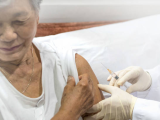Sep 21, 2010 (CIDRAP News) – Coming a month after federal officials released a blueprint for overhauling the nation's civilian biodefense program, the US Department of Health and Human Services (HHS) today announced the award of eight contracts worth up to $100 million to modernize and speed the development of countermeasures against natural and man-made disease threats.
The contracts, awarded by HHS's Biomedical Advanced Research and Development Authority (BARDA), are targeted toward innovations that reduce countermeasure time and development costs, testing, and production time and boost the safety, efficacy, and ease of use of the products. The HHS said the measures will also help address pandemic vaccine issues raised in August in a report from President Obama's science advisors.
Contracts announced today provide for $55 million in the initial stages, with up to $100 million over 3 years.
The eight companies and their innovations include:
- VaxDesign Corp., based in Orlando, Fla., for its MIMIC platform, a test-tube–based human immune system mimetic that could be used alongside animal testing to evaluate candidate and stockpiled vaccine safety and effectiveness
- PATH, based in Seattle, for strategies to increase the shelf life of influenza vaccines, a $5.2 million contract that was announced by the company earlier this month
- Infectious Disease Research Institute (IRDI), based in Seattle, to develop and evaluate new adjuvants that can boost the immunogenicity and cross-protection of vaccines against new flu strains
- Pfenex, Inc., based in San Diego, for its high-yield platform for producing a stable anthrax vaccine candidate
- Novartis Vaccines and Diagnostics, based in Cambridge, Mass., to investigate techniques for the rapid development of better influenza seed strain viruses
- Rapid Micro Biosystems, Bedford, Mass., to develop a method to accelerate influenza vaccine sterility testing
- 3M in St Paul, Minn., and Northrop Grumman Security Systems, in Baltimore, to develop integrated diagnostic capabilities needed for rapid, high-throughput surveillance and molecular diagnostics.
The HHS said the Novartis and Rapid Micro Biosystems contracts together could help shave weeks off of flu vaccine production and lot release schedules. Problems with seed strains and the slow process of sterility testing were among the factors that delayed the delivery of the 2009 H1N1 vaccine last fall.
Federal officials used a contracting tool called a broad agency announcement, which is designed to solicit innovations in four broad countermeasure areas: technology to accelerate countermeasure vaccine and drug evaluation; formulation chemistry, protein stabililization, and vaccine delivery technology; innovating processing and manufacturing methods; and diagnostic test advancements to speed infectious disease diagnosis.
Dr Phil Russell, former senior adviser to the HHS Office of the Assistant Secretary for Preparedness and Response, told CIDRAP News that the list of contracts looks promising and that all companies are good ones. "They're all pretty good projects," said Russell, who is on the board of the Sabin Vaccine Institute and is former director of the Walter Reed Army Institute of Research.
He said the contracts designed to shorten pandemic vaccine production are especially important; however, he said he's not as convinced that the mimetic vaccine testing platform will be as valuable as some experts claim.
Though he praised the contract list, he said it doesn't address the development of a vaccine potency assay, an issue that Russell said has been identified in several government and scientific forums. In December 2009 MedImmune recalled some lots of its nasal-spray pandemic vaccine due to a slight loss of potency, and during the winter Sanofi shortened the expiration date for some of its pandemic vaccine lots due to potency losses that were more rapid than expected.
See also:
Sep 21 HHS press release
Aug 19 CIDRAP News story "HHS sees greater federal role in building biodefense tools"


















